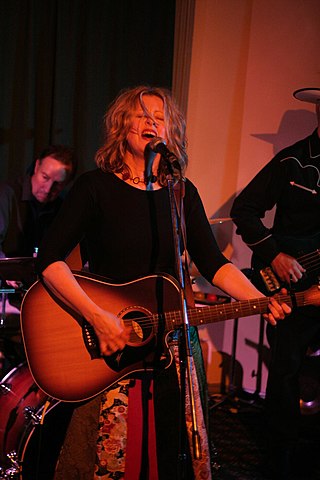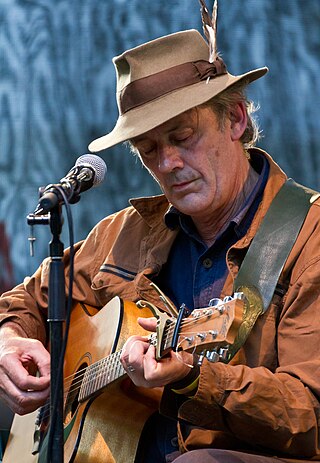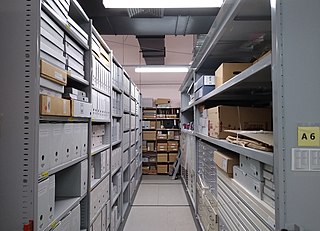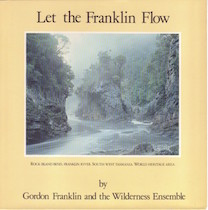Related Research Articles

Midnight Oil are an Australian rock band composed of Peter Garrett, Rob Hirst (drums), Jim Moginie and Martin Rotsey (guitar). The group was formed in Sydney in 1972 by Hirst, Moginie and original bassist Andrew James as Farm: they enlisted Garrett the following year, changed their name in 1976, and hired Rotsey a year later. Peter Gifford served as bass player from 1980 to 1987, with Bones Hillman then assuming the role until his death in 2020. Midnight Oil have sold over 20 million albums worldwide as of 2021.

Arts Centre Melbourne, originally known as the Victorian Arts Centre and briefly called the Arts Centre, is a performing arts centre consisting of a complex of theatres and concert halls in the Melbourne Arts Precinct, located in the central Melbourne suburb of Southbank in Victoria, Australia.

The Nuclear Disarmament Party (NDP) was an Australian political party formed in June 1984. It was founded by medical researcher Michael Denborough as the political arm of the Australian anti-nuclear movement, which had been active since the early 1970s.

Goanna is an Australian rock band which formed in 1977 in Geelong as The Goanna Band with mainstay Shane Howard as singer-songwriter and guitarist. The group integrated social protest with popular music and reached the Top 20 on the Australian Kent Music Report Singles Chart with "Solid Rock" (1982) and "Let the Franklin Flow". Their debut album, Spirit of Place, peaked at No. 2 on the related albums chart. They disbanded in 1987 and briefly reformed in 1998.

Spirit of Place is the debut studio album by Australian folk rock band Goanna. It was originally released in November 1982, it peaked at No. 2 on the Australian Kent Music Report Albums Chart and was certified double platinum by May 1983.

The Sidney Myer Music Bowl is an outdoor bandshell performance venue in Melbourne, Victoria, Australia. It is located in the lawns and gardens of Kings Domain on Linlithgow Avenue close to the Arts Centre and the Southbank entertainment precinct. It was officially opened by the Prime Minister of Australia, Robert Menzies, on 12 February 1959, with an audience of 30,000 people. It is listed on the Victorian Heritage Register.
John Lewis Schumann is an Australian singer-songwriter and guitarist from Adelaide. He is best known as the lead singer for the folk group Redgum, with their chart-topping hit "I Was Only 19 ", a song exploring the psychological and medical side-effects of serving in the Australian forces during the Vietnam War. The song's sales assisted Vietnam Veterans during the 1983 Royal Commission into the effects of Agent Orange and other chemical defoliants employed during the war. Schumann was an Australian Democrats candidate in the 1998 federal election, narrowly failing to unseat Australian Foreign Minister Alexander Downer for the Division of Mayo.
Neil James Murray is an Australian musician, singer-songwriter-guitarist and writer. He was a founding member of the Warumpi Band which was the first major influential Aboriginal rock group with mostly Indigenous members. Murray was recognised as one of Australia's foremost songwriters at the APRA Awards of 1995 by winning Song of the Year for "My Island Home".

Mirka Madeleine Mora was a French-born Australian visual artist and cultural figure who contributed significantly to the development of Australian contemporary art. Her media included drawing, painting, sculpture and mosaic.
William Robert Wood is a British-born Australian who has campaigned on peace and justice issues. He was elected to the Australian Parliament in the 1987 elections as Senator for New South Wales, however the High Court subsequently declared his election was invalid as he was not an Australian citizen at the time.

Suzie Dickinson was an Australian musician and songwriter. Originating from Melbourne, she was the lead singer and guitarist in the folk band Banshee, which was critically acclaimed for its original arrangements of American, Irish, English and Australian folk music and lilting, imaginative vocal harmonies. During this time Dickinson won two of Melbourne's "Free Entertainment in the Parks" awards for Most Popular Female Vocalist and Most Popular Female Folk Musician. Banshee was a regular guest on Shirley Strachan's TV show Shirl's Neighbourhood.

Shane Michael Howard is an Australian singer-songwriter and guitarist, he was the mainstay of folk rock group Goanna which had hit singles with "Solid Rock" and "Let the Franklin Flow" on the Kent Music Report and their album, Spirit of Place. After their disbandment he pursued a solo career.

"US Forces" is the first single released from Australian rock band Midnight Oil's fourth studio album, 10, 9, 8, 7, 6, 5, 4, 3, 2, 1. The song, which denounces US military intervention in foreign affairs, charted at no. 20 in Australia.

The Australian Performing Arts Collection at Arts Centre Melbourne, formerly known as Performing Arts Museum (PAM), is the largest specialist performing arts collection in Australia, with over 780,000 items relating to the history of circus, dance, music, opera and theatre in Australia and of Australian performers overseas.
Martha Ansara is a documentary filmmaker whose films on social issues have won international prizes and been screened in Australia, the UK, Europe and North America. Ansara was one of the first women in Australia to work as a cinematographer, is a full member of the Australian Cinematographers Society (ACS) and was inducted into the ACS Hall of Fame in 2015. Martha is a Life Member of the Australian Directors Guild and a founding member of Ozdox, the Australian Documentary Forum. She has also worked as a film lecturer and film writer and has been active in the trade union, women's and peace movements.
Ruth Maddison is an Australian photographer. She started photography in the 1970s and continues to make contributions to the Australian visual arts community.

"Let the Franklin Flow" is a song written by Shane Howard and recorded by Australian band Goanna. The song was released in April 1983 as a protest song to save the Franklin River from being dammed in Tasmania, Australia. "Let the Franklin Flow" peaked at number 12 on the Australian Kent Music Report.
Julia Church is an Australian artist and has works in painting, printmaking, poster art and graphic design. She is also an author having written multiple books and journal articles on Australian women's art and artistic culture. Her work is held in the collection of the National Gallery of Australia.
Jan Dunn born in Springvale, Victoria, Australia, was a potter, ceramicist and teacher.
Philip Gudthaykudthay, also known as Pussycat, was an Aboriginal Australian artist. His work is held in many public galleries in Australia and internationally, including the British Museum.
References
- 1 2 "Flyer for Stop the Drop, Sidney Myer Music Bowl, 1983". Arts Centre Melbourne. Retrieved 1 August 2022.
- 1 2 Segarini, Phil (5 March 1983). "Stop The Drop". Juke Magazine .
- 1 2 "Badge - Stop the Drop Disarm Now (part of), 1983". Museums Victoria Collections. Retrieved 1 August 2022.
- 1 2 3 4 "'Stop the Drop' concert t-shirt". collection.maas.museum. Retrieved 1 August 2022.
- ↑ "What's On". Tribune . No. 2209. New South Wales, Australia. 7 October 1981. p. 12. Retrieved 3 August 2022– via National Library of Australia.
- 1 2 Hewitt, Andrew (11 January 1983). "Stop The Drop – Concert programme". People for Nuclear Disarmament. p. 2.
- ↑ Ricketson, Matthew (3 February 1983). "Rock with a cause". The Age .
- 1 2 "2008/42/1 T-shirt, nuclear disarmament, 'Stop the drop', polyester / cotton, maker unknown, worn by Kevin Fewster at the 'Stop the drop' concert, Melbourne, Victoria, Australia, 1983". Powerhouse Museum. 2008. Archived from the original on 10 August 2008. Retrieved 3 August 2022– via National Library of Australia.
- ↑ "35 Years Ago Today Melbourne Played Host to One of the Great Aussie Concert Lineups". Mix 94.5. 13 February 2018. Archived from the original on 25 March 2018. Retrieved 3 August 2022– via National Library of Australia.
- 1 2 "Stop The Drop". Tribune. 16 February 1983. Retrieved 1 August 2022.
- ↑ Eliezer, Chris (7 April 1984). "Why The See Red". Juke Magazine . p. 11.
- 1 2 "Howard Schumann". Greater Port Macquarie Focus. Archived from the original on 23 March 2019. Retrieved 3 August 2022– via National Library of Australia.
- ↑ "Recommended Listening – All Fired Up: Lost Treasures of Australian Music". Miles Ago. Retrieved 1 August 2022.
- ↑ McFarlane, Ian (1999). "Encyclopedia of Australian Rock and Pop / Encyclopedia entry for 'Goanna'". Whammo. Archived from the original on 24 June 2004. Retrieved 1 August 2022.
- ↑ Kent, David (1993). Australian chart book 1970-1992. St Ives, NSW: Australian Chart Book. ISBN 0-646-11917-6. OCLC 38338297.
- ↑ McFarlane, Ian (1999). "Encyclopedia of Australian Rock and Pop / Encyclopedia entry for 'Midnight Oil'". Whammo. Archived from the original on 13 August 2004. Retrieved 1 August 2022.
- ↑ "Canberra Times awarded UN peace prize". Canberra Times. 21 October 1983. Retrieved 1 August 2022.
- ↑ Goodbun, Rodney (7 June 1983). "After the Rally". Tharunka. Retrieved 1 August 2022.
- 1 2 Dark, David (24 June 1983). "Stopping The Drop – Rock explodes a message". Herald.
- ↑ "1984 'Stop the Drop' concert t-shirt". collection.maas.museum. Retrieved 1 August 2022.
- ↑ "'Hot Bagels at Launch". Australian Jewish News. 16 November 1984. Retrieved 1 August 2022.
- ↑ "'Stop the drop - disarm now! Midnight Oil, Mental as Anything, Spy vs Spy, Invisible Mendez. Anti-nuclear movement benefit concert for peace, Memorial Drive 4pm Sun, Feb. 5th.' [poster] - Archives". archivescollection.anu.edu.au. Retrieved 1 August 2022.
- ↑ "SA 'Stop the Drop' concert boosts morale, finance". Tribune. 15 February 1984. Retrieved 1 August 2022.
- ↑ Fisher, Gillian (1995). Half-life : the NDP : peace, protest, and party politics. Sydney: State Library of N.S.W. Press. ISBN 0-7305-8958-7. OCLC 36671573.
- ↑ Various – Stop the Drop But Don't Stop the Bop , retrieved 1 August 2022
- ↑ "Young voices combine in 'Pacific Harmony'". Canberra Times. 8 August 1985. Retrieved 1 August 2022.
- ↑ "Stop the drop : disarm now! / People for Nuclear Disarmament". State Library Victoria. Retrieved 1 August 2022.
- ↑ "Stop the drop: a concert for nuclear disarmament | People for Nuclear Disarmament | 1983 | ACMI collection". Australian Centre for the Moving Image (ACMI). Retrieved 1 August 2022.